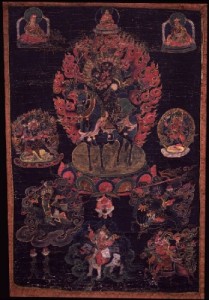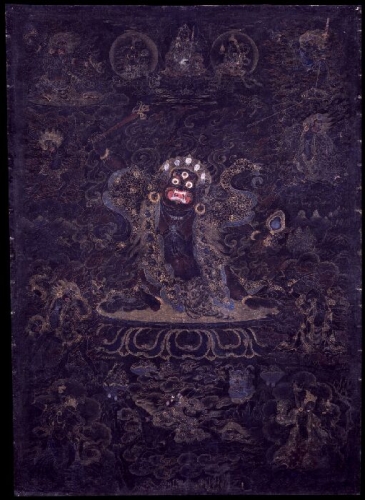Buddhist practice and Buddhist art have been inseparable in the Himalayas ever since Buddhism arrived to the region in the eighth century. But for the casual observer it can be difficult to make sense of the complex iconography. Not to worry—Himalayan art scholar Jeff Watt is here to help. In this “Himalayan Buddhist Art 101” series, Jeff is making sense of this rich artistic tradition by presenting weekly images from the Himalayan Art Resources archives and explaining their roles in the Buddhist tradition.
Protector Deities of Tibetan Origin
Last week we looked briefly at protector deities and the two principal figures of Mahakala and Shri Devi. Aside from the forms of those two that were derived from Indian Buddhist literature, there were also other forms that developed in Tibet, although these too were based on the Indian forms. Even though they are Tibetan in origin, because they are categorized as belonging to the group of Mahakala and Shri Devi, they are still considered to be wisdom deities.

An example of Mahakala and Shri Devi do not appear to have Indian roots are Palden Lhamo and Bernagchen. In the image at left, these two figures appear together seated atop a donkey with Palden Lhamo (Shri Devi) as the main figure facing forward and Bernagchen (Black Cloak Mahakala), the secondary figure, facing towards her and with his back facing the donkey.
Palden Lhamo and Bernagchen in this unique iconographic form are particular to the Karma Kagyu tradition of Tibetan Buddhism and are considered to be the special protector, as a pair, of the Karmapas and followers of that school. The painted example depicted here is known as a nagtang or black ground painting, which is derived from the various Mahakala Tantra source literature of India.

Worldly protector deities are a specialty of Tibetan Buddhism. Drogdze Wangmo, Mistress of the Charnal Ground, is an example of a wrathful female protector deity associated with specific “revealed” treasure (terma) teachings of the Nyingma tradition of Tibetan Buddhism. She is commonly found depicted in paintings as either a central figure or a minor figure, belonging to the Mindolling lineage of the Nyingmapa.
In a horrific form, and often surrounded by terrifying retinue figures who are denizens of the cemeteries and charnal grounds, she holds in her right hand a heart freshly acquired from an enemy and in her left hand a mirror to reflect the karmic deeds of those she is protecting against. Very specific protectors of Tibetan origin such as Drogdze Wangmo are not widespread in Tibetan Buddhism and generally remain associated within the lineage and within the context of teachings in which they were created.
Thank you for subscribing to Tricycle! As a nonprofit, we depend on readers like you to keep Buddhist teachings and practices widely available.